If you’re worried that you’ve missed the boat on Instagram marketing, don’t panic. There’s arguably no better time to learn the platform. With an ever-growing user base and a slew of fresh business features, building a community and selling to your target audience on Instagram is possible for brands big and small.
But standing out from the crowd on a platform with over one billion active users is a tall order. That’s why it’s so important to understand Instagram’s best practices and how to make your presence pop.
In this guide, we’ll break down what you need to know to master Instagram for business.
Step 1: Putting Together a Profile That Attracts Followers
First thing’s first: you need to make sure that your Instagram profile “looks the part.” If you haven’t already, make sure you’ve converted to an Instagram Business account so you can take full advantage of features like analytics and ads in the future.
Simply go to your Settings and select “Switch to a Professional Account.”

Then, select a category and confirm. You’re good to go!
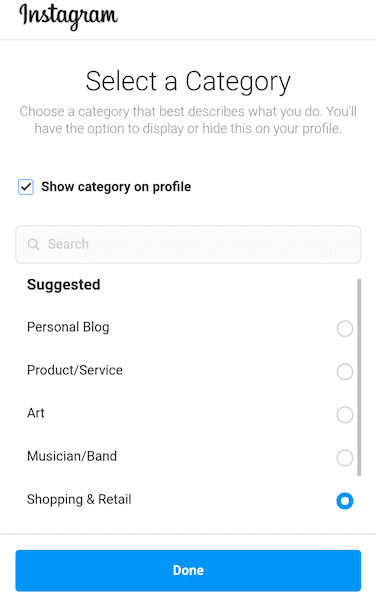
After filling out your business’ basic information (think: username, location), you’re going to need to pay close attention to your Instagram bio. This is a key step in optimizing your Instagram profile.
Because your bio is the first element of your account that people see, it’s incredibly valuable real estate. Ideally, your bio should show off your brand’s personality while also encouraging potential customers to interact.
Within 150 characters, most business Instagram bios include:
- A call-to-action or invitation (“shop…”, “check out…”)
- A brand hashtag (think: #TargetFinds) and/or slogan
- A link to a store, landing page, or other promotion
For example, check out how Rifle Paper Co. includes their own hashtag alongside a link to their site and storefront.
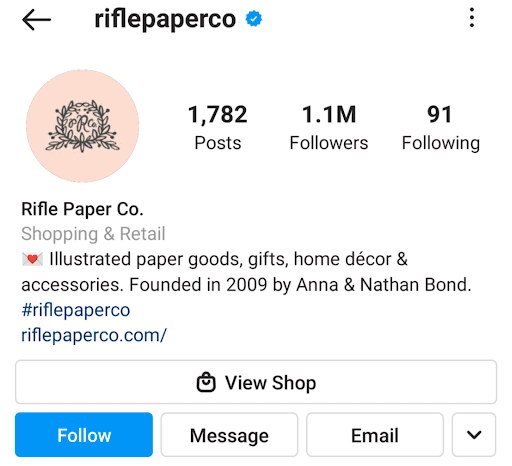
And here’s an example of an influencer-style bio, coupled with hashtags and emojis that feel personable at a glance.
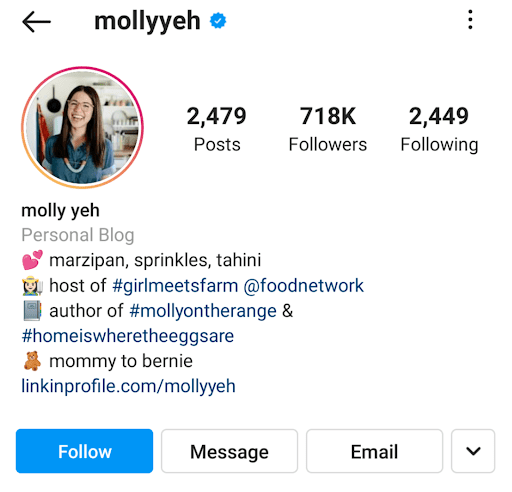
Beyond your bio, your profile picture should also be crystal clear to users on mobile screens (think: the size limit is 110×110). For brands, this traditionally means using some sort of minimalist, easy-to-read version of your company logo.
And for solo businesses or personal accounts, this means using a stylish headshot.
You’d be surprised at how many low-effort Instagram profiles are out there. Just make sure you’re highlighting what your brand is all about and point your followers to the proper promotions from the word “go.”
Step 2: Coming Up with a Compelling Content Strategy
There’s no shortage of content types that you can publish on Instagram. Below is a quick primer on the types of media you should prioritize as you brainstorm your content strategy.
Photos
No surprises here. Even with so many other content formats, photos are the foundation of Instagram marketing. For business, you have the creative freedom to publish:
- Photos of your products or services in action
- Pictures of you or your team behind the scenes
- Memes, image macros, and inspirational photos
However, arguably the most impactful photos when it comes to Instagram for business are customer photos. Serving as social proof, you can regram user-generated content to show off your satisfied customers and engage with your audience at the same time.
Videos
The correlation between video content and engagement on Instagram is well-documented. With in-feed video lasting up to 60 seconds, brands have the flexibility to create:
- Bite-sized promos or commercials
- Behind the scenes footage of your business
- How-tos and tutorials
Carousels
Recent research notes that Carousels on Instagram are among the most popular content on the platform. In short, a carousel simply serves as a tappable slideshow of photos. An upside of using Carousels is that they’re interactive and likewise encourage users to spend more time on your page as they move from photo to photo. Carousels are perfect for showing off multiple views of a product or progress photos over time.
Instagram Stories
Stories are integral to Instagram marketing today. These time-sensitive, short-form slideshows disappear after 24 hours and are ideal for making announcements, showing off customers, and asking questions of your followers. There are tons of creative tools built into Stories, such as tagging and stickers, too.

You can also save your Instagram Stories highlights so they appear on your home feed, allowing you to house all of your customer photos or new announcement posts in one place.

Perhaps the biggest benefit of Instagram Stories is that the feature allows you to cut in front of your followers’ feeds. Whenever you post a story, your profile pops up first until another brand or user posts their own. Brands that publish frequent Stories are more likely to stay fresh in their customers’ minds.

Instagram Reels
The platform’s answer to TikTok, Instagram Reels are 15-30 second looping videos. They’re relatively new in terms of content formats, but Instagram has emphasized them recently in their new feature rollouts. From tutorials and skits to challenges and beyond, publishing Reels is a smart move as more and more brands go all-in on video content.

Step 3: Understanding the Instagram Algorithm (and How to Maximize Engagement)
Before you begin posting content, we need to review the basics of the Instagram algorithm.
In short, the algorithm determines which accounts and pieces of content receive reach and get served to people on Instagram. This includes followers and content published to the platform’s search and home pages.
We don’t need to get too into the nitty-gritty. For now, just know that reach on Instagram is largely influenced by three key factors:
- How much engagement (likes, shares, saves, comments) any given post receives
- The usage of captions and hashtags to highlight what a piece of content is about
- Consistent publishing and variation when it comes to content types
Keeping these factors in mind will make the process of marketing your business on Instagram much less daunting. Below are some specific tips to feeding the Instagram algorithm what it once.
Stick to a Publishing Schedule
This is huge. The more consistently you post, the more likely you are to gain traction and get exposure. But let’s be clear: this isn’t a matter of sacrificing quality for quantity.
Many brands publish on a daily or near-daily basis, meanwhile regularly publishing Stories about as often as necessary. What you publish (and how often) ultimately depends on your time, budget, and resources.
We recommend sticking to some sort of content calendar to make sure you have something in the pipeline (check out the calendar from Iconosquare). Likewise, you can use tools like Later, HootSuite, or Sprout Social to map out and schedule your content accordingly if you’re willing to make the investment.

In addition to publishing consistently, consider the best times to post on social media based on when your audience is most active. Here’s some additional engagement data, based on research from Sprout Social, that can serve as a starting point. Since “optimal” timing varies from business to business, you should assess for yourself when your own “best’ timing is.
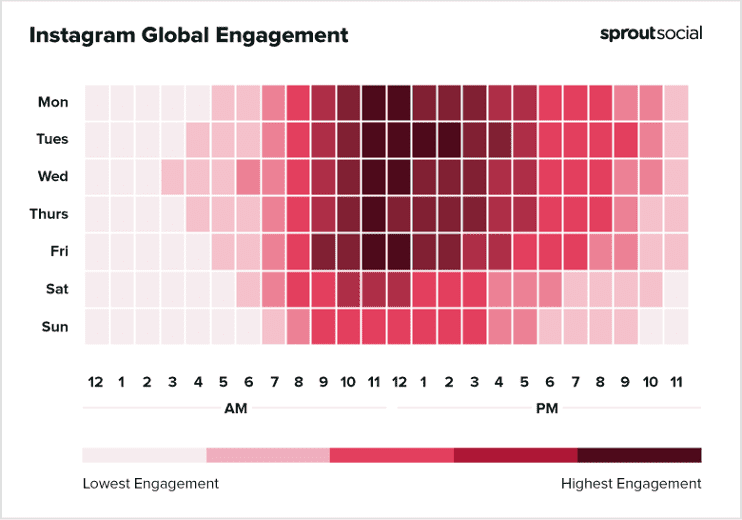
The key takeaway here is that you can’t post at random and expect to see returns for your Instagram marketing.
Consider Your Captions and Hashtags
Much like your bio, captions are also incredibly important real estate.
From snappy taglines to storytelling, there is no one-size-fits-all approach to writing captions. As Instagram has become more and more search-friendly, finding natural ways to integrate terms relevant to your brand or industry is a smart move.
Also, don’t forget about searching for hashtags to couple with your Instagram posts. Many brands will post between two and five tags per post, although posting more in the second comment of a post is also fair game.
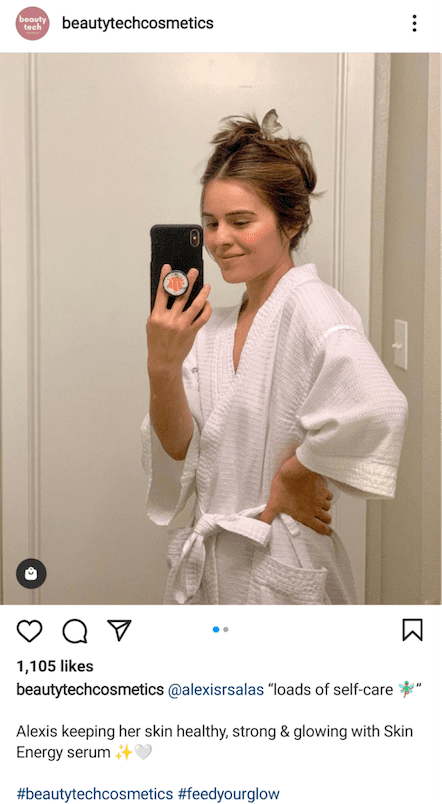
Again, hashtags can help your content get picked up in Instagram’s native search or topic pages. They’re a low-hanging way to make your content more discoverable.

Make a Point to Engage with Other Accounts
Upping engagement rates should be a top priority for any brand. Not just for the sake of the algorithm, but the fact that more likes and comments mean that your Instagram marketing is actually resonating with customers.
You can’t simply expect interactions to come flooding in automatically. Instead, you can encourage them naturally by:
- Engaging and commenting on other accounts (think: partners, employees, brands you admire)
- Publishing user-generated content and tagging customers
- Responding to questions and comments that your customers pose

Step 4: Monetizing Your Instagram Presence
Let’s say a long-term goal of your Instagram marketing is to translate your presence into dollars and cents. Good! Doing so represents a long game, but there are plenty of ways to make it happen.
Instagram Influencers
Working with influencers on Instagram is a prime way to not only build brand awareness but also sell products directly to relevant customers.
The concept here is simple: you partner with an influencer with an established following and they promote your products for you. In turn, they receive a commission and you gain credibility by being associated with an established account. For up-and-coming brands, the relationship is a win-win.

The effectiveness of influencer marketing for the sake of sales and reach is something we’ve seen firsthand. With tools like IZEAx Discovery, you can uncover the right influencers for your business and budget without having to reach out or dig through a bunch of accounts by hand.
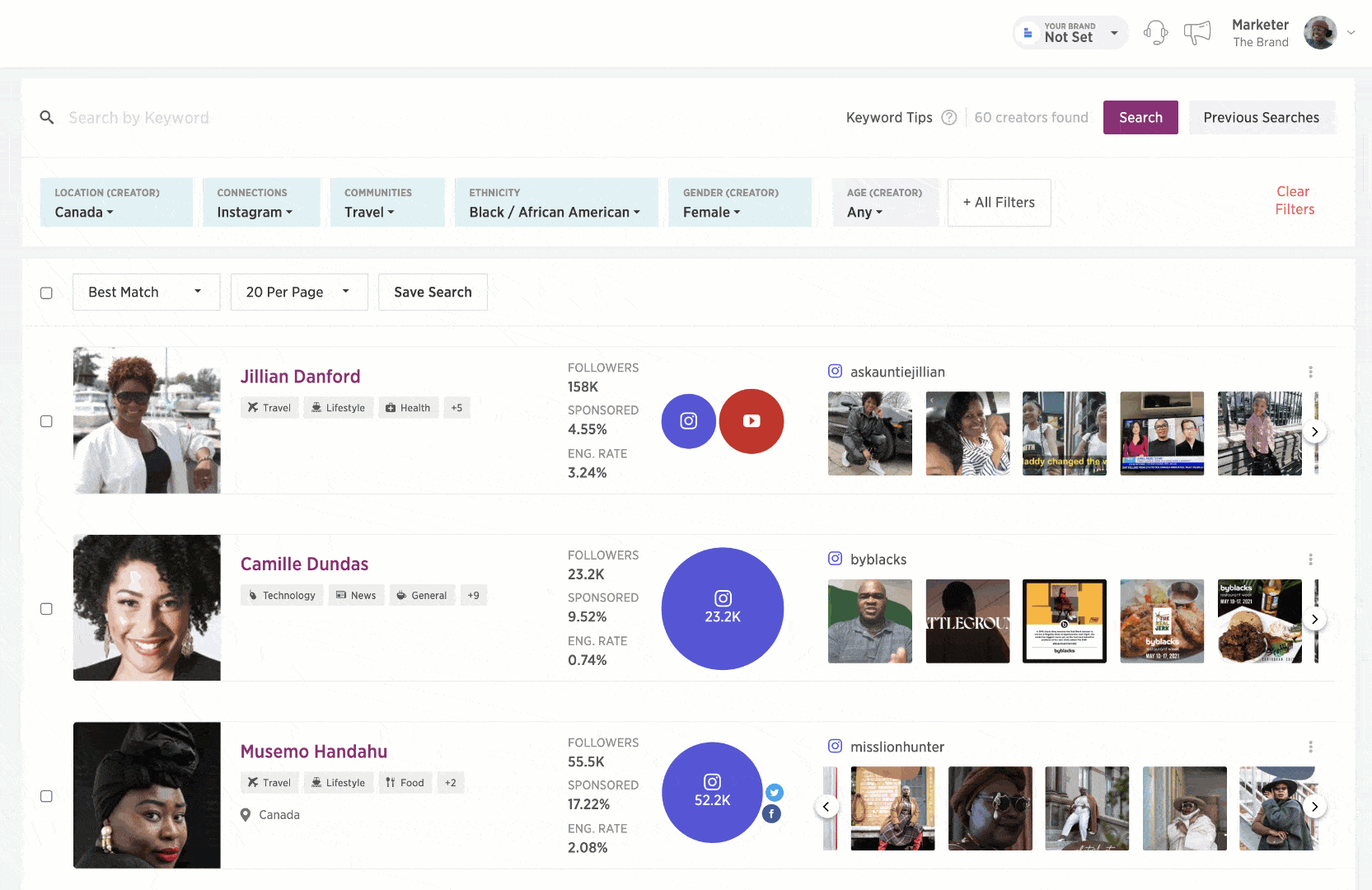
Instagram Shopping
For larger e-commerce brands, Instagram shopping is an awesome way to encourage followers to browse your products without having to leave Instagram. Even if users don’t buy directly, the ability to research products on the platform can help solidify their purchasing decision down the line.

Instagram Ads
If you’re already familiar with Facebook ads, you’re in luck: Instagram ad campaigns run off of the same platform. With tons of creative ad types and targeting options (including Stories ads), you can zero in on your target audience and serve ads that feel like an organic post.

Step 5: Analyzing Your Instagram Performance to Encourage Growth
If you want to see long-term growth and actual returns for your Instagram marketing, look no further than your analytics.
Whether it’s content-specific metrics (think: “Likes” or comments on a post) or your follower count over time, improving your numbers means regularly assessing what’s working and what isn’t.
Specifically, brands should make a point to track:
- The average engagement rate of any given post
- Which types of posts receive the most engagement
- Average followers gained/lost from month-to-month
- Audience demographics (think: age, location)
- Which hashtags are your top-performers
You can learn all of the above with a third-party tool like Hootsuite…
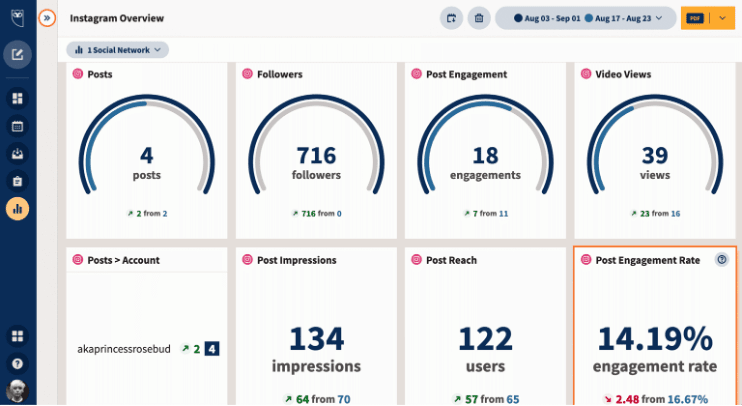
…but Instagram’s built-in analytics can be eye-opening as well.

Either way, do regularly reporting to ensure that you’re moving the needle and actually growing.
Ready to Rev up Your Instagram Marketing?
Running an Instagram account for business isn’t without its challenges, especially if you’re starting from scratch. But if you approach your presence step-by-step and stick to the tips above, you’ll be surprised at how quickly you can grow.
And if you’re interested in how influencers can fit into your marketing campaigns, find out which of our influencer marketing solutions is right for you.













